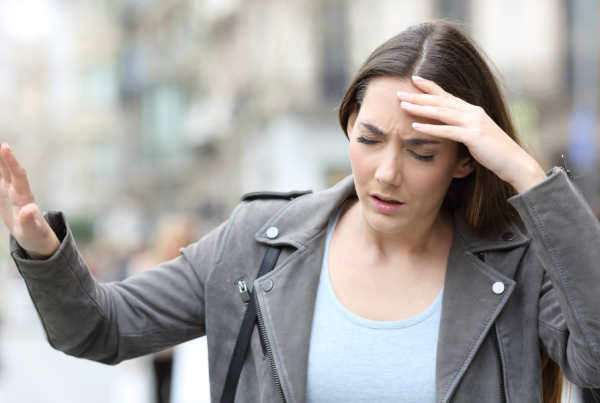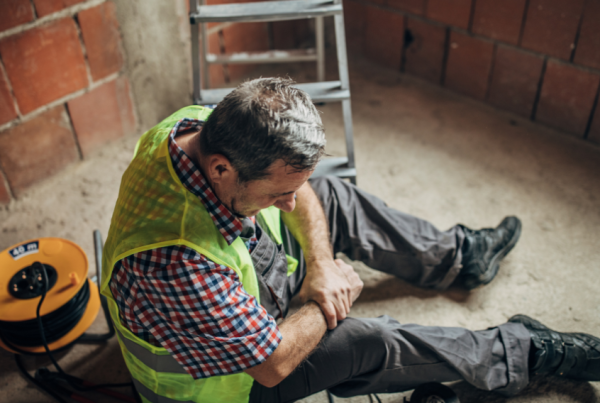Vestibular Rehabilitation
Move Better. Live Fuller. Your Wellness Journey Starts Here.
Schedule a FREE Discovery Call!
What Is Vestibular Rehabilitation?
Vestibular rehabilitation is a form of therapy that is catered to vestibular dysfunction or disorders, which are conditions that affect the body’s ability to balance. Vestibular disorders often cause dizziness, vertigo, and problems with hearing or vision—although symptoms vary depending on the specific condition.
In terms of physical therapy, vestibular rehabilitation specifically looks to improve an individual’s balance and strength, as well as reduce dizziness. The specifics of the rehabilitation therapy vary by the patient and their condition, needs, and symptoms.

These symptoms are caused because vestibular dysfunction affects your spatial orientation and the sensory system in your body, disconnecting the body’s ability to balance properly. Therefore, vestibular rehabilitation works to solve this disconnect.
As mentioned before, symptoms of vestibular disorders vary depending on the condition, but some common symptoms seen across many conditions include the following:
- Loss of balance
- Dizziness
- Vertigo (a false sense of spinning or swaying that causes disorientation)
- Blurry vision or nystagmus (uncontrollable and repetitive eye movements)
- Nausea
- Spatial disorientation (inability to determine your position in space)
- Hearing loss or tinnitus (ringing in the ears)
These symptoms can come about at random, or have specific triggers that may cause them. Some common triggers can include quick head movements or changes in position, as well as visual overstimulation. The duration and onset of these symptoms also vary, such as only being episodic or persistently lasting for a long period of time.
Who Needs Vestibular Rehabilitation?
Individuals who experience the above-mentioned symptoms will want to speak with a professional and receive an actual diagnosis, so that they can receive the treatment that will best suit their needs. Some common conditions that often need vestibular rehabilitation therapy include the following:
- Benign paroxysmal positional vertigo (BPPV): An inner ear disorder caused by tiny canalith particles that move out of place, causing movement sensitivity. This sensitivity results in dizziness and vertigo.
- Meniere’s disease: A disorder caused by a buildup of fluid in the inner ear, which disrupts balance and causes vertigo, tinnitus, and hearing loss.
- Vestibular neuritis: This condition is caused by the inflammation of an inner ear nerve, disrupting balance signals that are sent to the brain. This inflammation can cause intense vertigo and dizziness, nausea, and trouble with balance.
- Labyrinthitis: A condition that affects the portion of the inner ear responsible for balance—the labyrinth. When the labyrinth becomes inflamed, it can cause balance issues, hearing loss, and vertigo.
- Acoustic neuroma: This condition refers to the growth of a noncancerous tumor that affects the nerves of the inner ear. It can cause vestibular dysfunction and symptoms that may worsen if not treated.
- Bilateral vestibular hypofunction (BVH): A chronic condition resulting from defects in the vestibular organs. Causes problems with balance or vision, particularly with movement.
- Cervicogenic dizziness: A condition categorized by vertigo, dizziness, and neck pain. Has a variety of causes such as trauma, spinal injuries, joint problems, and neck conditions.
- Vestibular migraines: Migraines that are accompanied by symptoms of vertigo or dizziness. The reasoning for this condition is unknown.
- Post-concussion effects: Some symptoms of vestibular dysfunction can be caused by the lasting effects of a concussion.
- Ototoxicity: Loss of inner ear function due to the frequent usage of certain medications.
- Age-related vestibular dysfunction: Gradual loss of vestibular function due to age.
Physical Therapy for Vestibular Rehabilitation
Physical therapists can diagnose, treat, and manage vestibular disorders. For diagnosis, they will first discuss your medical history and symptoms, as well as perform an evaluation which may include specialized tests. This may include gait assessment, balance tests while walking or standing, position tests, eye movement tests, or other specialized vestibular tests.
After determining a diagnosis, they will then determine the best course of treatment for your specific needs and condition, creating a comprehensive and individualized plan that may include in-office sessions and at-home practice. In this care plan, they may utilize the following methods to manage your symptoms:
Canalith Repositioning
For individuals with BPPV, where tiny canalith particles may cause a disruption in the inner ear (hereby causing dizziness and vertigo), the canalith repositioning procedure can shift these particles to an area where they do not cause disruption.
This procedure involves shifting the head or body into different positions and holding those positions for some amount of time, under the supervision of your physical therapist.
Habituation
This activity has a goal of desensitizing the patient to a trigger, in order to reduce the negative effects of that trigger. It involves repeated exposure to the trigger, such as certain movements or positions that provoke symptoms. While this sounds counterproductive, it actually reduces the patient’s sensitivity to the trigger over time.
Gaze Stabilization
This activity involves having the patient move their head while looking at a target to improve their ability to maintain their gaze on the object. This can be done in a few different methods:
- Having the patient move their head side to side or up and down while focusing on a stationary target.
- Having the patient move their head while moving a target in the opposite direction.
Balance Training
Your physical therapist will guide you through safe exercises that will improve your body’s overall balance, to counteract the loss of balance associated with vestibular disorders.
Strength and Endurance Training
Similarly to the previous point, strengthening the lower body and improving the body’s endurance can improve overall stability and support balance to counteract symptoms.
Pain Management
Pain-relieving treatments may be suggested to help with the additional side effects of vestibular symptoms, such as neck pain.
Safety and Education
Includes teaching patients management strategies for their specific condition and symptoms, as well as how to safely perform exercises at home. Other strategies for safety may involve suggestions on how to modify home or work environments to reduce the patient’s fall risk.
Exercise Prescription
Managing symptoms will be much easier with at-home practice. Your physical therapist will curate a safe at-home exercise or practice routine for you!
Sensory Reorganization
A common symptom of vestibular dysfunction is loss of sensory orientation, meaning the body is unable to make out its location or position in space. Therefore, physical therapists may use proprioceptive training to enhance the body’s sense of position.
Relaxation Techniques
The sudden onset of symptoms such as vertigo can be distressing. Physical therapists can assist in teaching relaxation techniques to ease anxiety or stress induced by vestibular disorders.
The physical therapists at Hive Therapy and Wellness use a variety of treatments to provide a comprehensive healing experience. In addition to the above-mentioned methods, you may also expect to experience the following treatments while under our care:
- Dry needling
- Cupping
- Manual therapy
- Spinal manipulation
- Electrical muscle stimulation
- Tissue scraping
- Exercise prescription
- Behavioral modifications
- Therapeutic modalities
- Neuromuscular re-education
- Biofeedback
- Therapeutic activity
Vestibular rehabilitation is a form of therapy that is catered to vestibular dysfunction or disorders, which are conditions that affect the body’s ability to balance.
Vestibular disorders often cause dizziness, vertigo, and problems with hearing or vision—although symptoms vary depending on the specific condition.
These symptoms are caused because vestibular dysfunction affects your spatial orientation and the sensory system in your body, disconnecting the body’s ability to balance properly. Therefore, vestibular rehabilitation works to solve this disconnect.
In terms of physical therapy, vestibular rehabilitation specifically looks to improve an individual’s balance and strength, as well as reduce dizziness. The specifics of the rehabilitation therapy vary by the patient and their condition, needs, and symptoms.
As mentioned before, symptoms of vestibular disorders vary depending on the condition, but some common symptoms seen across many conditions include the following:
- Loss of balance
- Dizziness
- Vertigo (a false sense of spinning or swaying that causes disorientation)
- Blurry vision or nystagmus (uncontrollable and repetitive eye movements)
- Nausea
- Spatial disorientation (inability to determine your position in space)
- Hearing loss or tinnitus (ringing in the ears)
These symptoms can come about at random, or have specific triggers that may cause them. Some common triggers can include quick head movements or changes in position, as well as visual overstimulation.
The duration and onset of these symptoms also vary, such as only being episodic or persistently lasting for a long period of time.
Individuals who experience the above-mentioned symptoms will want to speak with a professional and receive an actual diagnosis, so that they can receive the treatment that will best suit their needs. Some common conditions that often need vestibular rehabilitation therapy include the following:
- Benign paroxysmal positional vertigo (BPPV): An inner ear disorder caused by tiny canalith particles that move out of place, causing movement sensitivity. This sensitivity results in dizziness and vertigo.
- Meniere’s disease: A disorder caused by a buildup of fluid in the inner ear, which disrupts balance and causes vertigo, tinnitus, and hearing loss.
- Vestibular neuritis: This condition is caused by the inflammation of an inner ear nerve, disrupting balance signals that are sent to the brain. This inflammation can cause intense vertigo and dizziness, nausea, and trouble with balance.
- Labyrinthitis: A condition that affects the portion of the inner ear responsible for balance—the labyrinth. When the labyrinth becomes inflamed, it can cause balance issues, hearing loss, and vertigo.
- Acoustic neuroma: This condition refers to the growth of a noncancerous tumor that affects the nerves of the inner ear. It can cause vestibular dysfunction and symptoms that may worsen if not treated.
- Bilateral vestibular hypofunction (BVH): A chronic condition resulting from defects in the vestibular organs. Causes problems with balance or vision, particularly with movement.
- Cervicogenic dizziness: A condition categorized by vertigo, dizziness, and neck pain. Has a variety of causes such as trauma, spinal injuries, joint problems, and neck conditions.
- Vestibular migraines: Migraines that are accompanied by symptoms of vertigo or dizziness. The reasoning for this condition is unknown.
- Post-concussion effects: Some symptoms of vestibular dysfunction can be caused by the lasting effects of a concussion.
- Ototoxicity: Loss of inner ear function due to the frequent usage of certain medications.
- Age-related vestibular dysfunction: Gradual loss of vestibular function due to age.
Physical therapists can diagnose, treat, and manage vestibular disorders. For diagnosis, they will first discuss your medical history and symptoms, as well as perform an evaluation which may include specialized tests.
This may include gait assessment, balance tests while walking or standing, position tests, eye movement tests, or other specialized vestibular tests.
After determining a diagnosis, they will then determine the best course of treatment for your specific needs and condition, creating a comprehensive and individualized plan that may include in-office sessions and at-home practice.
In this care plan, they may utilize the following methods to manage your symptoms:
Canalith Repositioning
For individuals with BPPV, where tiny canalith particles may cause a disruption in the inner ear (hereby causing dizziness and vertigo), the canalith repositioning procedure can shift these particles to an area where they do not cause disruption.
This procedure involves shifting the head or body into different positions and holding those positions for some amount of time, under the supervision of your physical therapist.
Habituation
This activity has a goal of desensitizing the patient to a trigger, in order to reduce the negative effects of that trigger. It involves repeated exposure to the trigger, such as certain movements or positions that provoke symptoms. While this sounds counterproductive, it actually reduces the patient’s sensitivity to the trigger over time.
Gaze Stabilization
This activity involves having the patient move their head while looking at a target to improve their ability to maintain their gaze on the object. This can be done in a few different methods:
- Having the patient move their head side to side or up and down while focusing on a stationary target.
- Having the patient move their head while moving a target in the opposite direction.
Balance Training
Your physical therapist will guide you through safe exercises that will improve your body’s overall balance, to counteract the loss of balance associated with vestibular disorders.
Strength and Endurance Training
Similarly to the previous point, strengthening the lower body and improving the body’s endurance can improve overall stability and support balance to counteract symptoms.
Pain Management
Pain-relieving treatments may be suggested to help with the additional side effects of vestibular symptoms, such as neck pain.
Safety and Education
Includes teaching patients management strategies for their specific condition and symptoms, as well as how to safely perform exercises at home. Other strategies for safety may involve suggestions on how to modify home or work environments to reduce the patient’s fall risk.
Exercise Prescription
Managing symptoms will be much easier with at-home practice. Your physical therapist will curate a safe at-home exercise or practice routine for you!
Sensory Reorganization
A common symptom of vestibular dysfunction is loss of sensory orientation, meaning the body is unable to make out its location or position in space. Therefore, physical therapists may use proprioceptive training to enhance the body’s sense of position.
Relaxation Techniques
The sudden onset of symptoms such as vertigo can be distressing. Physical therapists can assist in teaching relaxation techniques to ease anxiety or stress induced by vestibular disorders.
The physical therapists at Hive Therapy and Wellness use a variety of treatments to provide a comprehensive healing experience. In addition to the above-mentioned methods, you may also expect to experience the following treatments while under our care:
- Dry needling
- Cupping
- Manual therapy
- Spinal manipulation
- Electrical muscle stimulation
- Tissue scraping
- Exercise prescription
- Behavioral modifications
- Therapeutic modalities
- Neuromuscular re-education
- Biofeedback
- Therapeutic activity
You can learn more about these treatments on our Treatments Page.





